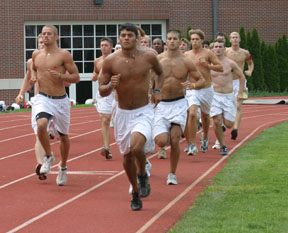Training camps for fall sports athletes — at Wabash and local high schools — are well underway. And compared to the temperatures and high humidity that blanketed Indiana at the end of July, this week seems like a breeze, relatively speaking.
 The lower temperatures didn’t keep Wabash football players from dropping like flies on the first official day of Training Camp on Monday. Head Athletics Trainer Mark Colston reports treating 11 men for heat-related illness, including one who had to be taken to the hospital to be stabilized.
The lower temperatures didn’t keep Wabash football players from dropping like flies on the first official day of Training Camp on Monday. Head Athletics Trainer Mark Colston reports treating 11 men for heat-related illness, including one who had to be taken to the hospital to be stabilized.
According to Colston, now in his second year at the helm of Wabash’s training room, heat isn’t always the number one crippling factor for high school and college athletes. "When it’s not as hot, they don’t think they need to drink as much water," Colston said.
"Simply stated, the body's cardiovascular system adjusts to external heat during exercise by shunting blood to the skin, which improves the body's ability to cool itself by dissipating internal heat, but diminishes the blood supply to the working muscles," writes Michigan State University's Ken Mannie. "This "catch-22" stresses the cardiovascular system to meet the competing demands of the thermoregulatory system and the requirements of muscle metabolism.
"If the air temperature is mildly warm, the body can release a portion of the internal heat overload through sweat evaporation. When high humidity is coupled with warm air temperature, the body's thermal stress is doubled and the body's ability to evaporate the sweat and cool itself may be stifled."
 At Wabash, Colston and his assistant, Mark Elizondo, carefully monitor athletes and insist coaches build in water breaks at peak points during practices. None of the 11 Wabash football players affected by the heat were seriously injured, though all showed signs of exhaustion and loss of fluids.
At Wabash, Colston and his assistant, Mark Elizondo, carefully monitor athletes and insist coaches build in water breaks at peak points during practices. None of the 11 Wabash football players affected by the heat were seriously injured, though all showed signs of exhaustion and loss of fluids.
"Heat illness is a very serious matter and watching the athletes' weight before and after practices is one way to determine who might be at risk," said Colston. "Those athletes who drop pounds have lost ‘water weight’ which will need replaced."
The trainers also monitor humidity and temperature levels and discuss with coaches adjustments they might make to their practice schedules. Colston urges all athletes to drink at least 64 ounces of Wabash in a "normal" day and significantly more when working out or practicing. Once practice starts, water breaks should be taken every 10 or 15 minutes. "Prevention is the key to avoiding heat illness," he said.
"Our athletes are usually the first to recognize their own symptoms of heat illness. We tell them that if they feel faint, nauseas, experience blurred vision, rapid pulse, and increased perspiration, to take the time to find a cool place, get some water, and call for help."
Wabash’s soccer and cross country teams report to pre-season training camps later this week.
For more information see: